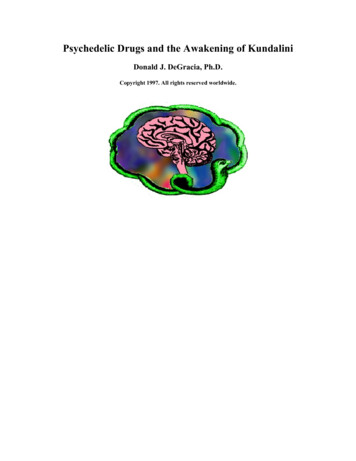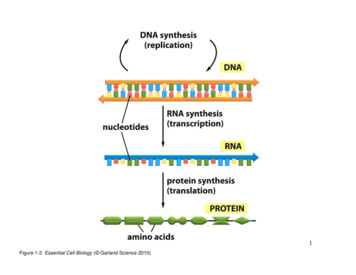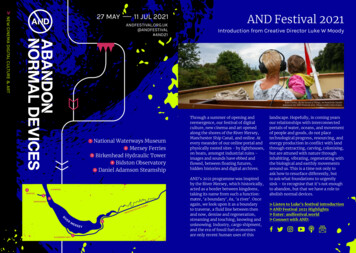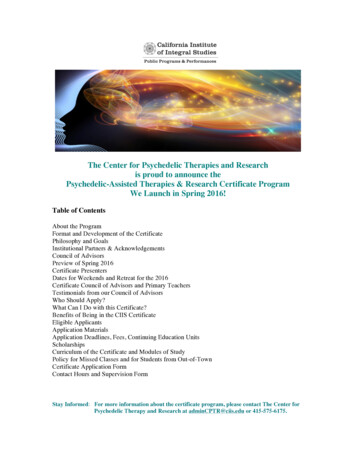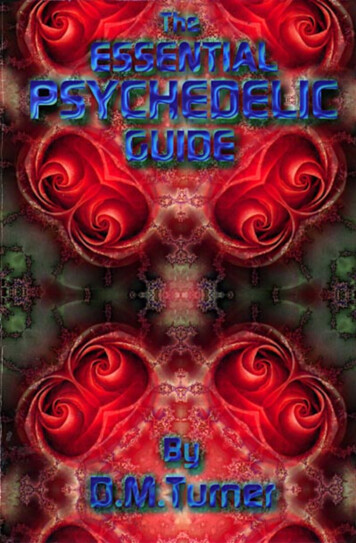
Transcription
The Essential Psychedelic Guide - By D. M. TurnerFirst Printing - September 1994Copyright 1994 by Panther Press ISBN 0-9642636-1-0Library of Congress Catalog registration in progress Printed in the United States ofAmericaCover art by Nick Philip, SFX Lab Illustrations on pages 31, 41, 45, and 59 by P.B.M.D. M. Turner is a trademark of Panther Press.Selected excerpt from The Doors of Perception by Aldous Huxley. Copyright 1954by Aldous Huxley. Copyright renewed 1982 by Laura Huxley. Reprinted bypermission of HarperCollins Publishers Inc. and Chatto & Windus Ltd.Selected excerpt from The Holotropic Mind by Stanislav Grof and Hal Zina BennettCopyright 1992 by Stanislav Grof and Hal Zina Bennett. Reprinted by permissionof HarperCollins Publishers Inc.All rights reserved. No part of this book may be reproduced in any manner withoutthe written permission of the publisher.Warning: Many of the substances discussed in this book are currently illegal in theUnited States and many other parts of the world. The author and publisher do notadvocate breaking the law, and will not be held responsible for use or misuse of theinformation contained herein. This book was written to expand the body ofknowledge available on psychedelics and is not a recommendation or endorsement oftheir use.Additional copies of this book may be ordered for 14.95 each. ( 12.95 2.00shipping and handling) CA residents add 0.94 tax for credit card orders add 1.00processing fee.For Visa - Mastercard orders only phone (415) 753-6481.For mail orders and international orders see Purchasing The Essential PsychedelicGuideFor wholesale inquiries and any other information write to:Panther Press1032 Irving, #514San Francisco, CA 94122
TABLE OF CONTENTSPublication InformationForeword to the PDF Edition - by Forbidden DonutIntroductionA Brief History of Psychedelics - From the Creation of Gods to the Demise ofPsychedelic Reverence in Modern TimesPsychedelic Safety - Understanding the ToolsI - Traditional PsychedelicsLSD - Molecule of PerfectionPsilocybin Mushrooms - The Extraterrestrial Infiltration of Earth?Mescaline: Peyote & San Pedro Cactus - Shamanic SacramentsII - EmpathogensEcstasy - The Heart Opening Psychedelic2C-B - The Erotic EmpathogenIII - Exotic Highs of a ConnoisseurDMT - Candy for the MindHarmala Alkaloids - Link to the Ancient SpiritsKetamine - The Ultimate Psychedelic JourneyMultiple Combinations - Cosmic Synergism
Further Explorations - Where do we go from Here?DMT Water Spirit - A Magical LinkPsychedelic Reality - CydelikSpaceBibliographyPurchasing The Essential Psychedelic GuideBack Cover Text
Foreword to the PDF Editionby Forbidden DonutYou, dear reader, are an extremely fortunate individual to have stumbledupon this particular digital doorway. What lies ahead is one of the mostimportant volumes in the canon of psychedelic literature. The EssentialPsychedelic Guide was written by D.M. Turner, an extraordinarilycourageous and articulate pioneer in the exploration of the imaginal realm.However, due to a tragic series of events resulting in the untimely death ofits author, this book was very nearly lost forever. Only a few psychonautslucky enough to have found copies from the initial print runs would haveever been the wiser. Luckily, though, some mysterious force for good in theuniverse has seen fit to digitize it for your reading pleasure. I, for one, amawfully thankful.The Essential Psychedelic Guide, while deceptively slim in its printed form,is a veritable well-spring of knowledge for the aspiring psychonaut. Itbrings together in a single volume the basics of psychedelic history,essential information on physical and mental safety, and detailed chapterson 8 of the major entheogens, including hard to find, accurate data ondosage and administration. Turner also presents quite a bit of highly novelthinking with regard to the philosophical underpinnings of the bizarre,extreme, and sometimes sublime dimensions that entheogens can makeaccessible. Indeed, one could scarcely dream of a better introductory text forthe newcomer to the visionary way, or a more practically useful referencefor the experienced psychedelic voyager.What really puts Turner's work in a class by itself are his vivid, lucid andevocative narrations from the very frontier of consciousness itself. His tripstories convey the essence of the psychedelic experience in a manner that Ihad not previously thought to be possible using such a crude instrument asthe English language. Also particularly noteworthy is the wide variety ofnovel and challenging chemical combinations which this master alchemistbrought together within his physical alembic and then reported on. Thismakes the work especially important, as he was likely the first and onlyperson ever to have tried some of these mixtures. Some may considercertain of them to be excessive or even dangerous; indeed, Turner's deathappears to have been directly related to one of his experiments. Followinghis death, it has been pointed out that he was a bit of a "hard-head"; it tookhim much higher dosages than most need to acheive the desired effects.
'Caution' is the watchword, especially for newcomers to the psychedelicarena. Nevertheless, we must remember that Turner was the Chuck Yeagerof psychonauts, a test pilot's test pilot. His voyages should therefore bejudged accordingly.The sad circumstances regarding his demise, however, have cast aforeboding shadow over some of his more intrepid adventures, andunfortunately have turned a hero's story into a cautionary tale. On or aboutDecember 31, 1996, Turner prepared for another voyage, presumably tocelebrate the coming of the new year. Sadly, it was to be his last. Shortlythereafter he was found dead, drowned in his bathtub, with a vial ofketamine nearby. It seems likely that he either slid beneath the waterlinewhile under its effects, or slipped, fell, and hit his head upon arisingafterwards, leaving himself unconscious to drown in several inches of water.In light of Turner's glowing praise for ketamine in this book, how exactly isthe reader supposed to view the fact that it seems to have played at least asupporting role in his passing? My own favorite interpretation is from ananonymous friend's recollection of Turner in the Summer 1997 issue of TheResonance Project:Mr. Turner was in the process of revising his Essential PsychedelicGuide, but as the changes may never come to light, it should be statedthat his opinion of ketamine had changed considerably. He was sensitiveto safety issues, and was increasingly troubled by what he called the'psychedelic heroin' properties of ketamine. He confided in friends thatDMT, which he considered his most helpful ally, had a difficult timecounteracting the addictive and increasingly life-negative effects of thisdrug. DMT conveyed to him that ketamine was a sort of 'Frankensteinmolecule' that didn't obey the shamanic rules, and he was given severalwarnings to drop it from his program. Ultimately, his failure tocompletely do so led to his untimely passing.Whether or not one entirely agrees with the preceding quote, I believe that itoffers the most useful perspective from which to learn from the great lossthat the psychedelic community suffered on New Year's Eve 1997. Ifnothing else, I hope that Turner's death inspires us all to be just a little morecareful when surfing the cosmic jetstream. Indeed, if only he had a sitternearby on his final voyage, he might still be among the living. Also, I wouldhope that this tragedy might teach us to more fully listen to our personalintuition's guidance as regards these powerful tools, using it as a balance bywhich to gauge the veracity of what the materials themselves may tell us inone of their capricious moods. During the thirty-four years he spent in hisincarnation as D.M. Turner, he touched innumerable lives with his warmth,wisdom, honesty, courage, and kindness. And thankfully, he has left us with
a rich and impressive legacy. Enjoy.Forbidden Donut,September 29, 1997
Over 300 mushroom stones have been found throughout Mesoamerica,some dating as far back as 1000 B.C. The mushroom stone above wasfound in the Guatemalan highlands and was one of the first to bediscovered. Photograph reprinted courtesy of Wasson Library, HarvardBotanical Museum.INTRODUCTION"Psychedelics" are substances with the ability to expand human awarenessbeyond our normal modes of perception. The family of psychedelicsincludes plants, such as psilocybe mushrooms, that have been used in"shamanistic" settings for thousands of years, as well as recently developedsynthetic compounds, like LSD and ecstasy.Psychedelics may be the most amazing substances known to humanity.Some are so potent that just 1/10,000th of a gram can send one on a journeybeyond time and space, beyond life and death. Here the psychedelic voyagercan unlock and experience the collective evolutionary consciousness ofbillions of years past and an infinite future. He can transcend the body, the
personality, and view his mind from undreamed-of perspectives. He canexperience supersensory and extrasensory perception, choose from aninfinite variety of "realities," and permanently change his experience of life.I am writing this book because in this primitive time of political powerstruggles and the "war on drugs," most information on psychedelics thatreaches the public is negatively biased and erroneous. There is a lack ofaccurate information available regarding: the history of psychedelics, howthey are consumed, dosage levels, effects and experiences produced, andwhether they are safe.I've tried to focus on the less common psychedelics and on combinations,while also discussing more familiar substances such as LSD, psilocybin,and MDMA. In my 18 years as a psychedelic user and researcher I havefound only a few references to some of the more exotic psychedelics,frequently incomplete and written by people who had not experienced themfirst hand. The information presented here draws upon my research, as wellas extensive personal experience with these substances, and involvement incommunities where they are used. There are many things I have notattempted to cover in these few pages, and I recommend the reader to thefollowing books:THE PSYCHEDELIC EXPERIENCE - This is the premier "trippingguide" which is useful to anyone trying to understand the states of mindproduced by psychedelics. It is the most thorough description I have seen ofthe changes and experiences one is likely to go through on a psychedelicvoyage. However, this book is an adaptation of an Eastern spiritual text, andmay seem esoteric and difficult to understand for those not familiar with thestates it describes.PLANTS OF THE GODS - This gives a brief overview on the history ofseveral plant psychedelics that have been used since ancient times. Having along term perspective on the use of psychedelics can give one a betterunderstanding of how these substances have affected human societies. Manypeople today don't even know that psychedelics existed before the Sixtiesand that the last 30 years are just the latest paragraph in psychedelic history.FOOD OF GODS - Author Terence McKenna eloquently expounds histheories on the role of psychoactive plant use throughout human evolution.His theories are startling yet well grounded and offer a comprehensive viewof the relationship between humans and mind-altering plants.Other books are listed in the various chapters, as well as the bibliographywhich also lists sources for the books that are in print.
I consider my research a work in process, by no means definitive orcomplete. With psychedelics we are taking our first steps into a realm ofinfinite possibilities, like the first amphibians stepping on dry land, or amore accurate metaphor, like the first humans leaving earth's atmosphereand venturing into space. I believe there will come a day when humanityrecognizes psychedelics as the universal medicine, ambrosia of the heavens,and keys to higher intelligence.There are numerous other methods for entering altered states being totedabout, from meditation and yoga to brain machines and virtual reality. I'vetried many of these methods, enjoy them, and have found them mostvaluable used with psychedelics. But to compare the experience of thesemethods on their own to the experience of psychedelics is like comparing acandle to the sun. Other methods don't even approach the realm of liquid,flowing, digital dreams which can be accessed by psychedelics like DMT!A BRIEF HISTORY OF PSYCHEDELICSFROM THE CREATION OFGODS TO THE DEMISE OFPSYCHEDELIC REVERENCEIN MODERN TIMESAs prehistoric men and women foraged for food they must have eaten thepsychedelic plants which grow in nearly all regions of the world. Ingestingthese plants would have produced awe inspiring experiences, and it is quitelikely that the origin of ideas about gods, heavens and hells, life after death,etc. began with the ingestion of psychedelic plants.Try to imagine yourself as a neolithic human, most of your attention givento day-by-day survival, the more complex areas of your brain just beginningto develop. Now ingest say, a handful of psilocybin mushrooms, or thepsychedelic root of the African Iboga plant. Imagine what wealth of imagesand information would now be flowing through your mind! In his recentbook, Food of the Gods, Terence McKenna presents a plausible hypothesisthat homosapiens descended from psychedelic-using hominids. The ability
of psychedelics to facilitate development of the human brain is an importantpart of his theory.Worship involving psychedelic plants and their use in spiritual pursuits canbe traced to the beginnings of recorded history. The major role these plantsplayed in the formation of early religions has been documented by severalhistorians. R. Gordon Wasson has made a strong argument that theinebriating Soma of the ancient Indian Rg Veda was the Amanita muscariamushroom.1 Other historians have found evidence of psychedelic use in theEleusian and Dionysian rituals of ancient Greece.2 Other references topsychedelic plants can be found in ancient Buddhist, Hindu, and other farEastern texts. And in Africa, the use of Iboga was noted by the earliestEnglish explorers of the area.Psychedelic plants are much more abundant in the New World and to thisday play a part in the religions of the Native Americans. When the Spanishinvaded what is now known as Mexico and South America they executedpsychedelic-using natives, and the religions and healing practices wereforced underground. A strong shamanic tradition persisted for centuries. Inthe United States, only the Native American Church of North Americaretained legal permission to continue religious use of its psychedelicsacrament, Peyote.The knowledge of one psychedelic sacrament, the psilocybe mushroom, wasall but lost to Europeans for centuries. R. Gordon Wasson began his questfor knowledge about mushrooms in 1927, after he experienced a vastdifference in cultural attitude towards mushrooms between himself and hisRussian wife. Their research led to the understanding that the majority ofwesterners are mycophobics, havmg a fear or loathing of mushrooms.People in many other parts of the world are mycophiles, often being able todistinguish many types of mushrooms by sight, knowing which are edible,and having common names for the different species.Wasson explored all he could find about mushrooms through folklore,etymology, and references in literature and art. He came upon resultscompletely beyond anything he could have dreamed of: that mushroomswhich produce a "divine inebriation" have been used and worshipped innumerous times and in several areas of the worldWasson also discovered that an existing "mushroom cult" still continuedamongst certain Indians in Mexico, far removed from civilization. In 1955he managed to get in touch with these Indians and participated in amushroom ceremony guided by a 65 year old shamaness, possiblybecoming the first white man to eat psilocybin mushrooms in hundreds of
years. This story was published in Life magazine, May 13, 1957. It is anexcellent article with great pictures and a moving description of Wasson'sfirst mushroom voyage.Wasson continued exploring the ethnology of mushrooms and other plantsacraments used throughout the world, teaming up with the likes of famousethnobotanist Richard Evans Schultes, and Albert Hofmann, the inventorand discoverer of LSD. Through the Fifties and early Sixties the attitudesregarding psychedelics throughout the world were generally positive.Knowledge was confined primarily to the scientific and scholasticcommunities, with some attention from the art and literary circles. Papersand articles on psychedelics from this time period lack the hysteria, and theconnection of drug to sin that media introduced to the public in themid-Sixties.Well, what happened during the Sixties, and how did the majority's attitudetoward psychedelics get so screwed up? Here's a simple explanation; theU.S. government was afraid of the changes brought about by psychedelicuse. They used the physical, financial, and political forces they controlled tospread fear and discredit the virtues of psychedelics.None of what happened seems too surprising. It fits into the patterns thathuman minds are frequently seen to operate in. The majority of thepopulation is still the type that resists anything new, any change(neophobic). This mindset is continually reinforced through newspapers,television, government, religions, schools, and the hierarchical structure ofsociety. All of these organizations are dominated by people with neophobicmindsets. Most also possess the Judaeo-Christian concepts that: humans areevil, sex is evil, we are beneath Gods, we will be eternally punished if wedisobey the rules of the church, or, heaven forbid, take a psychedelic and tryto experience an ecstatic state of happiness.Many of the people reinforcing this mindset are not even aware that they arespreading negativity. They are supporting what they believe is correct.These people, convinced that the old morals are the "right way" of living,have generated outright lies about psychedelics, feeling anything whichdiscourages drug use is justified. Of course, other members of theseorganizations spread negative information with purely nefarious intentions,such as political groups who instruct the CIA to sell cocaine for financingcovert military operations, and then preach that drugs are the tools of thedevil on TV.The establishment's methods of spreading drug paranoia are numerous anduse all forms of media. Most of the population gets its information from the
neophobically controlled major media sources: television, newspapers, andlarge magazines. There is also political pressure at all levels to conform tothe views of the ruling politicians. Do you think CBS would broadcast anovertly pro-drug commercial even if you paid them well? The governmentalso controls the content of what is taught in schools. What is commonlycalled "drug education" is better defined as "anti-drug brainwashing." Anypositive appraisals of drugs are absent from school course materials.Teachers seldom inform their students that over 99.9% of the people whotake ecstasy have a positive experience. A recent psychiatric M.D. graduatefrom Harvard was not even aware that psychedelics had ever been used intherapy. Psychedelic use in therapy was widespread until LSD was madeillegal in 1966, and the results from their use were highly successful. Duringthe past 28 years limited research and therapy using psychedelics hascontinued, primarily in Switzerland and Germany (Although in recent yearsthe FDA has agreed to resuming a small number of studies involving humanuse of psychedelics here in the U.S.)Much of a psychedelic trip is based on a person's mental set. The negativemedia on psychedelics causes many people to take these substances withunwarranted fears, thus diminishing the potential of the experience, andprobably causing some people to freak out. Someone embarking on a tripwith the idea "This substance is an ancient gift of the Gods, it will allow meto gain a new experience of life" will have a different experience than aperson with the idea "Someone told me this is fun, but it's illegal and I'mworried about getting busted, and I'm afraid I'll lose control and jump out ofa window. "There has always been some accurate information about psychedelicsavailable, but it's been something one's had to search for Many who havefound, understood, and applied this knowledge have benefited immensely.This book was written to spread this information to a larger group of peoplein hopes of enlightening many on the potentialities of the psychedelicexperience, and dispelling some of the misinformation that has previouslybeen disseminated on this topic.1. See Soma: Divine Mushroom of Immortality by R. Gordon Wasson.2. See The Road to Eleusis by Hofmann, Ruck, and Wasson.
PSYCHEDELICSAFETYUNDERSTANDING THE TOOLSThe natural psychedelics have been in use forthousands of years, and I anticipate that bothsynthetic and natural psychedelics will still be usedthousands of years from now.Contrary to being considered dangerous, throughout most of historypsychedelics have been considered gifts of the Gods, and have beenassociated with the healing of the body, mind and soul.History is full of shamans and shamanesses who consumed these substanceshundreds of times each year for their entire life and suffered no ill effects.1Likewise my thousand or so experiments with various psychedelics seem tohave done no harm. To the contrary, I feel I've received numerous benefitsfrom their use.I suspect most of the psychedelic scare stories published in the late Sixtiesand Seventies were generated by people pursuing their own political orfinancial agendas, or by people with fundamentalist morals who were afraidof losing their power, or even seeing people feel too good. Other scarestories were written purely for sensationalism to sell magazines andnewspapers. Many of the stories, such as LSD causing chromosomedamage, have been proven false. Other stories, such as the CIA's dosing ofunsuspecting people who went on to jump out of windows. Well, as RobertAnton Wilson says "They either didn't know what was happening to them,they thought they were losing their minds, and they jumped out of thewindow. Or they did realize what was happening, that the intelligenceagency of their own government was covertly giving them mind-alteringdrugs., and they jumped out of the window." A thorough review ofpsychedelic history will show that problems encountered throughpsychedelic use are rare, especially if you consider that in this countryalone, millions of doses of psychedelics are consumed each month.When I discuss psychedelic safety I think it's important to separate physicalsafety from mental safety. Physical safety deals primarily with the drugs andvarious combinations thereof. Mental safety is a much more individual issueand must be monitored and evaluated by each psychedelic user. This sectiondeals with general psychedelic safety. More information is given for specific
substances where appropriateI consider ecstasy and other synthetics of the phenethylamine familyexceptions in terms of psychedelic safety. These are amphetamine relativeswhich can mess up one's equilibrium, leaving one feeling physically drainedand mentally frizzled. I definitely monitor my intake of these substancesbut have not found occasional use of moderate doses to do any lasting harm.There have been a few cases reported in which people died fromdehydration after taking ecstasy at hot, crowded dance clubs, and attemptingto dance for several hours straight without drinking any water. Extremesituations like this have been avoided by most users by exercising someforethought.PHYSICAL SAFETY:Aside from the use of ecstasy and the Belladonna alkaloids, I know of butone case where someone experienced physical harm from psychedehc use.And this was with the ultimately potent combination of Harmaline and5-MeO-DMT. Anxiety about physical illness is a frequent response themind can generate when undergoing the psychedelic transformation, andoften the increased awareness of bodily functions can cause one to feel sick.It's useful to be able to distinguish whether a symptom is actually the resultof a substance, or just the mind's imagination. The book The PsychedelicExperience describes this quite well. On psychedelics it's also possible forone to become aware of the complex body/mind relationship, and discoverhow to ease bodily discomfort by releasing mental/emotional blocks.Whenever working with a new substance, the more cautious users will startwith a small dose and work their way up. During this period they can watchhow their body and mind responds to the drug and determine which dosageworks for them. This can be important since some people may havepowerful reactions to amounts which produce only minimal activity in mostpeople. Some psychedelics, such as LSD, have a wide margin between theactive dose and the amount which may be considered toxic. Otherpsychedelics, such as ecstasy, can exhibit toxic effects at just twice theaverage dose. Unfortunately, legal scientific research on these substances ispractically non-existent, and the maximum safe dosages have not beenaccurately calculated.It is not uncommon to feel nauseous on many of the psychedelics. Usersgenerally report that if they feel the urge to vomit it's best to not resist it,and that they usually feel better afterwards. Nausea is not an indication thatthere is something wrong with one's trip. Indigenous people are known tosay that Peyote, or Ayahuasca, acts as a purge, and is cleansing the body and
soul. They also say that when the body and soul are purlfied one will nolonger feel discomfort from the Peyote. I've often noticed that psychedelicspurge and cleanse my body in a manner similar to fasting Many usersexperiment with different diets or fasting prior to tripping, which caneliminate or reduce nauseous feelings during the trip.Some people feel exhausted or out of touch with reality the day after apsychedelic trip. This can be expected since they went through so muchduring the experience. Many users find it's good to have an extra day afterthe trip to recuperate before returning to work, etc. Avoiding familiarroutines for a day allows people to retain more from their psychedelicjourneys.Hopefully anybody using these substances knows that while high, it isdangerous to drive, fly a plane, etc. I'd like to emphasize this point since welive in a society where driving while intoxicated on alcohol is fairlycommon.Many people may have driven while mildly high on a psychedelic withoutgetting into accidents. However, I'm sure there are some who drove whiletripping and are no longer alive to tell about it. If one were to take a largedose of a psychedelic they would be in a state of mind where the world thatappears before their eyes is going through massive changes each moment.They may have difficulty recalling their name, and driving would be totallyout of the question. Smaller doses of psychedelics produce similar butmilder changes in one's consciousness. The psychedelic experience issimply not compatible with the split-second decisions and maneuvers onemust routinely make while driving around in a two-ton chunk of steel at 60MPH.I think that to get the most from a psychedelic experience one must putaside time completely devoted to the experience, and take a dose thatsignificantly alters perception. The "recreational" use of smaller amounts ofpsychedelics, as is common in social settings such as raves, concerts, andparties, seldom provides one with a full spectrum of the psychedelicexperience. This is not to say that using psychedelics in this context can notbe beneficial or enjoyable, but many people I have spoken with who haveused psychedelics in only this type of setting don't appear to have had deepor powerfully transformational experiences. In a situation wheretransportation is required, people should try to have a friend drive them,take a cab, or simply beam themselves wherever they wish to go!Anyone who has any type of health problem, or is taking prescription orover-the- counter medicines, should be cautious using psychedelics. Most
psychedelics increase pulse rate and blood pressure. The effects of usingpsychedelics with medical problems, or most prescription drugs, is largelyunknown. Anyone in this situation should find a knowledgeable andopen-minded doctor to give them some advice. Pregnant women should alsoconsult such a doctor prior to using psychedelics.The main physical danger with psychedelics is with those that are MAOinhibitors and with combinations. Two psychedelics discussed in this bookare MAO inhibitors: 5-MeO-DMT and the Harmala alkaloids. Manyprescription anti-depressant drugs are also MAO inhibitors. MAO (MonoAmine-Oxidase) is an enzyme in the body which breaks down certain foodsand chemicals. If one has these foods or chemicals in their system whiletaking an MAO inhibitor they will not be broken down, which can result indiscomfort, illness, or even death. Following this section is a list of itemsnot to be taken with MAO inhibitors. Prior to taking an MAO inhibitor Ireview this list and do a double check on what's in my system. I've alsofound it useful to memorize this list of items so that I don't eat any foodsthat will make me sick while using MAO inhibitors.MENTAL SAFETY:Each person's mind and capacity for handling psychedelics is different.Psychedelics are not for everybody, and some of the substances discussed inthis book are particularly heavy. Although most psychedelic trips areexperienced as baneficial, some people have had experiences that left themdistrurbed afterwards. The main reason for these negative experiences islack of preparation, rather tha
guide" which is useful to anyone trying to understand the states of mind produced by psychedelics. It is the most thorough description I have seen of the changes and experiences one is likely to go through on a psychedelic voyage. However, thi
